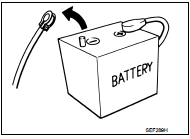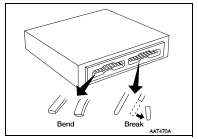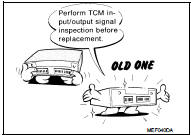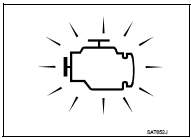Nissan Juke Service and Repair Manual : General Precautions
• Turn ignition switch OFF and disconnect the battery cable from the negative terminal before connecting or disconnecting the CVT assembly harness connector. Because battery voltage is applied to TCM even if ignition switch is turned OFF.

• When connecting or disconnecting pin connectors into or from TCM, do not damage pin terminals (bend or break).
Check that there are not any bends or breaks on TCM pin terminal, when connecting pin connectors.

• Perform TCM input/output signal inspection and check whether TCM functions normally or not before replacing TCM.
Refer to TM-354, "Reference Value".

• Perform “DTC (Diagnostic Trouble Code) CONFIRMATION PROCEDURE”.
If the repair is completed DTC should not be displayed in the “DTC CONFIRMATION PROCEDURE”.

• Always use the specified brand of CVT fluid. Refer to MA-13, "Fluids and Lubricants".
• Use lint-free paper not cloth rags during work.
• Dispose of the waste oil using the methods prescribed by law, ordinance, etc. after replacing the CVT fluid.
 Precaution for G Sensor Removal/Installation or Replacement
Precaution for G Sensor Removal/Installation or Replacement
CAUTION:
To remove/install or replace G sensor, refer to TM-377, "Description". ...
 On Board Diagnosis (OBD) System of CVT and Engine
On Board Diagnosis (OBD) System of CVT and Engine
The ECM has an on board diagnostic system. It will light up the malfunction
indicator lamp (MIL) to warn the
driver of a malfunction causing emission deterioration.
CAUTION:
• Be sure to turn t ...
Other materials:
Intelligent key battery
Removal and Installation
1. Release the lock knob at the back of the Intelligent Key and remove the
mechanical key.
2. Insert a flat-blade screwdriver (A) wrapped with a cloth into the
slit of the corner and twist it to separate the upper part from the
lower part.
CAUTION:
• Do not touch t ...
Diagnosis system (BCM) (with intelligent key system)
Common item : consult-III Function (BCM - COMMON ITEM)
APPLICATION ITEM
CONSULT-III performs the following functions via CAN communication with BCM.
SYSTEM APPLICATION
BCM can perform the following functions for each system.
NOTE:
It can perform the diagnosis modes except the following for ...
Engine Oils
Prolonged and repeated contact with used engine oil may cause skin cancer.
Try to avoid direct skin contact
with used oil.
If skin contact is made, wash thoroughly with soap or hand cleaner as soon as
possible.
HEALTH PROTECTION PRECAUTIONS
• Avoid prolonged and repeated contact with oils, ...
